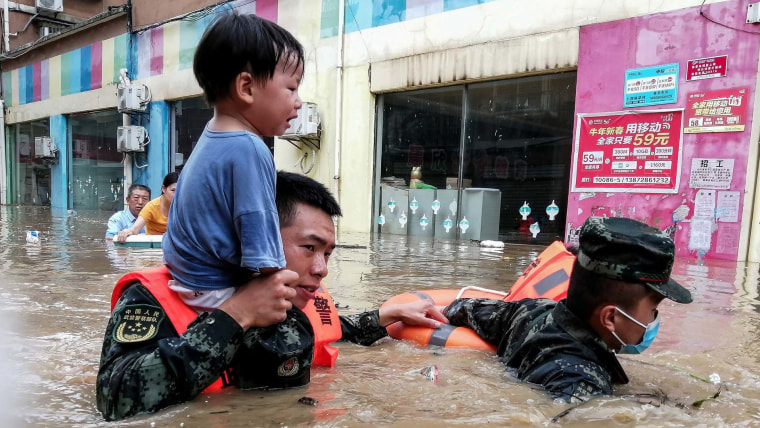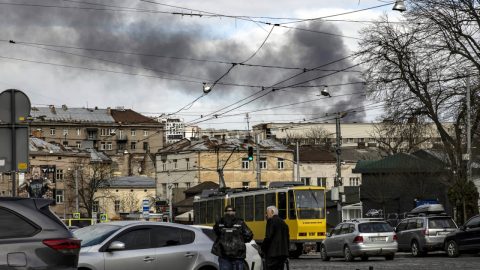China is a country of epic contradictions.
It is home to the world’s largest solar farm, a rolling ocean of 4 million panels high up in the Tibetan plateau that’s large enough to cover Manhattan. Some 600 miles to the east, in Inner Mongolia, are the belching smokestacks of the Tuoketuo power plant, the world’s largest coal-fired power station and one of the biggest single sources of pollution ever created.
On Sunday, at the start of COP26, the world may get a clue as to which of China’s two extremes will dominate the coming decades — and potentially shape the future of the world.
For the next two weeks the United Nations climate change conference is being hosted in Glasgow, Scotland. And most eyes will be on the team dispatched from Beijing.
China is the world’s largest polluter, pumping out more greenhouse gases than every other industrialized nation combined.
Many countries, including the United States, are still not doing enough to avoid damaging temperature rises this century, most experts say, something that United Nations Secretary General António Guterres said Monday was a “thundering wake-up call” ahead of COP26.
But China is coming under increasing pressure, not just because it is responsible for more than a quarter of global emissions, but because its promises to curb them have so far been less ambitious than those by the U.S., Europe and others.
“My appeal to China is very simple,” Guterres told a press conference, “that they will reach net-zero before 2060 and they will peak emissions before 2030.”
Some experts also worry that the current global energy crunch — which has left millions in China subject to power cuts and rationing that could last for months — may mean Beijing backslides even further on plans to wean itself off fossil fuels.
The stakes couldn’t be higher. No matter what the United States and Europe do, the world cannot avoid damaging temperature rises “without China achieving its climate goals,” Yanzhong Huang, a senior fellow at the Council on Foreign Relations, said. “We cannot afford for China to fail.”
Even amid Covid-19, COP26 will be vast: 25,000 delegates, dozens of world leaders, and appearances from Pope Francis and the Swedish activist Greta Thunberg. For many, it’s the best shot at softening an environmental calamity that has already been set in motion.
The aim is to flesh out legally binding targets set in the 2015 Paris Agreement, keeping global temperature rises “well below” 2 degrees Celsius this century, preferably 1.5 degrees.
But China’s plans so far have been “highly insufficient” to hit those targets, according to the Climate Action Tracker, a leading nonprofit database in Germany.
Instead, it says, Beijing’s policies are consistent with a 3-degree world, meaning sea-level rises, more extreme weather and possible mass starvation as swaths of the planet become inhospitable for crops and even human life itself.
On Thursday, Beijing submitted its updated climate goals, known as nationally determined contributions, or NDCs, ahead of COP26. But there was little new that hadn’t been announced before, namely that China pledges to start reducing carbon emissions before 2030 and achieve carbon neutrality by 2060, which President Xi Jinping announced last year.
The likely absence of the Chinese president, who has not left the country since the start of the pandemic, is also seen as ominous for hopes of any sort of major breakthrough.
Download the NBC News app for breaking news and politics
China’s Ministry of Ecology and Environment did not respond to requests for comment on the assessment that it’s policies are consistent with 3 degrees of warming.
Beijing says it is “fully in line” with the Paris Agreement, but still characterizes itself as a “developing country” that is still in the process of urbanization and industrialization, an official from China’s National Development and Reform Commission told state media this week. “So energy consumption will continue to grow.”
It’s fitting for this land of juxtaposition that China has both accomplished a vast amount on climate change while simultaneously not promising enough for the future. Gone are the days of China dismissing international pleas to curb spiraling emissions, its delegates wrecking previous climate summits by insisting wealthy countries shoulder the responsibility.
Now it wants to be seen as the central player.
On top of Xi’s 2030-2060 pledge, last month he announced the country would stop funding coal projects abroad. Previously Beijing bankrolled more than 70 percent of the coal plants being built or planned globally, according to the Beijing-based International Institute of Green Finance.
On renewables, Xi’s China added more wind energy last year than every other country combined. Its solar, hydroelectric and electric vehicle sectors dwarf any others, its 4.5 million electric cars making up nearly half of the global total.
But quitting coal will be brutal for a country powered 60 percent by the black stuff. One estimate by Beijing’s Tsinghua University said its net-zero goal would cost an incomprehensible $46 trillion.
Over the past 40 years, coal has turbocharged China’s rapid urbanization, keeping the lights on for 1.4 billion people, and powering the cement and steel industries that forge its infrastructure-based economy.
Without coal, China would not have lifted 800 million people out of poverty. And its attempts to kick the habit are already causing complaints that will be familiar to any country that’s tried to phase out seemingly essential dirty industries.
“The mines are all closed in my area — there are no more,” Zhou Duofu bemoans, saying he used to run mines employing 500 people in Hunan province. “My area was so prosperous,” he added, but government policy meant “we had to quit.”
China isn’t taking action on climate change to please the West. The Communist Party sees climate change as an existential threat — both to the country and the party’s control over it, said Judith Shapiro, a China climate expert who teaches at the American University in Washington.
This year, it suffered deadly flooding in Henan province, and 2020 was Asia’s hottest year on record, the United Nations said this week. Sea-level rises imperil low-lying megacities like Shanghai and its 25 million people.
The Communist Party “is full of scientists and engineers,” Shapiro said, “and they are very much aware” this is a “long-term national security risk.” Now the party “has to consider whether this is a new threat to its legitimacy,” she said.
In the short term, China may have another problem.
It has been hit harder than anyone by the global energy crunch, buckling under a shortage of coal and increased manufacturing demands. For weeks, blackouts have plagued millions of homes and businesses across 20 provinces.
Fallout from the crunch is a major worry ahead of COP26. Experts fear that the realpolitik of keeping the lights on means there’s less chance than ever of Beijing quitting coal in time. Indeed, Beijing has ordered all coal mines to operate at full capacity ahead of winter
“This year we should have started to see significant reductions in fossil fuel emissions,” according to Ma Jun, director of China’s Institute of Public and Environmental Affairs think tank, who says every country will face these pressures. “But unfortunately we’re likely to see a rebound.”
Beijing’s defenders say that while the United States may boast more ambitious climate promises, its governments are more focused on the short term and less likely to succeed than the dynastic vision set out by China’s technocratic one-party state.
And while China is the world’s No. 1 carbon dioxide emitter, it isn’t even in the top 40 when those emissions are broken down per person. The worst large countries in terms of pollution per capita are Saudi Arabia, Australia, Canada and the U.S.
Many international experts say there is also an inherent unfairness in global emissions calculations, which are based on what countries produce rather than what they consume. Put simply, the U.S. and others outsource much of their cheap and dirty manufacturing to China, allowing Americans to buy iPhones and Nike sneakers without taking responsibility for the carbon emissions they create.
“China essentially became the repository of the world’s pollution when it rose economically,” Shapiro at the American University said. “Much of the developed world’s pollution has been displaced onto China.”
China is also far from alone in needing to do more.
The U.S., the European Union and Japan have slightly more ambitious policies than Beijing, according to the Climate Action Tracker, but these are still “insufficient” to hit the 1.5-degree target. Nigeria and the United Kingdom are among those rated “nearly sufficient.” Gambia is the only “sufficient” country.
In this scale, China sits on a de facto naughty step along with Russia, Australia, Saudi Arabia and Canada — even when adjusted for their “fair share,” based on historical emissions and ability to act.
John Kerry, President Joe Biden’s special climate envoy, has put pressure on Beijing for being one of the few powers that haven’t adopted COP26’s net-zero target of 2050. “We can’t get where we need to go if China isn’t joining in that effort,” he told MSNBC’s “Morning Joe” last month.
But forget 2050, the only way to avert a crisis is for China to start acting almost immediately, reducing emissions by 2025 rather than 2030, according to Shuo Li, a senior global policy adviser for Greenpeace East Asia based in Beijing.
“That will create a lot of global momentum and it will earn China that global respect that it desires,” he said. “We need to embrace the hard work now.”










Recent Comments